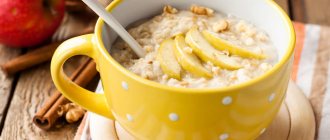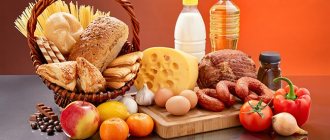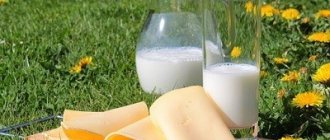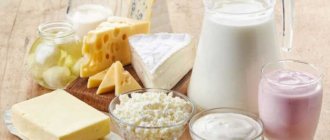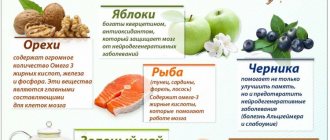Why are high hemoglobin levels negative for health? The main danger of this condition is associated with changes in the properties of the blood. If hemoglobin increases, it becomes viscous, thick, and the risk of blood clots and blockage of blood vessels increases. To avoid these dangerous processes, doctors prescribe medication.
Particular attention is paid to nutrition in case of elevated hemoglobin, recommending certain types of foods and excluding others from the patient’s diet - those that dangerously increase hemoglobin. Such measures help stabilize the level of iron in the blood, and therefore return hemoglobin values to normal.
How does diet affect hemoglobin?
According to research , hemoglobin levels actively increase when consuming foods rich in:
- iron;
- vitamins A, C, E, B-group;
- omega-3 unsaturated fatty acids (as well as omega-6 and omega-9).
Accordingly, they should be excluded, if possible, from the diet (not completely, consuming in a minimal amount purely to maintain the correct balance of nutrients in the body).
The hemoglobin molecule consists of protein (globin) and iron. The process of their connection is stimulated by the above-mentioned vitamins and micronutrients.
Even if you consume foods that are not rich in iron, but there is a deficiency of vitamins in the body, the bioavailability of iron will be reduced to a minimum. That is, it simply will not be absorbed in the required quantity.
In what cases does high hemoglobin most often occur? If the patient’s diet is dominated by:
- products of animal origin (meat, meat by-products);
- seafood;
- citrus;
- chocolate (and other desserts that contain large quantities of cocoa).
Let's remember that in the last article we looked at 20 products that increase hemoglobin.
Moreover, in such patients the amount of plant foods rich in fiber in the diet is minimal.
General rules
Hemoglobin , which is part of blood cells ( erythrocytes ), is a protein (globin) that contains iron (heme). Its main function is the transfer of oxygen from the lungs to the cells of organs and tissues, as well as the binding and removal of carbon dioxide into the lungs. The hemoglobin level is essentially an indicator of the amount of oxygen carried.
Normally, hemoglobin levels in men vary between 130-160 g/1 l and 120-140 g/1 l of blood in women. The level of hemoglobin can change under the influence of natural processes, as well as in the presence of disorders in various organs and systems of the human body.
Elevated hemoglobin is not an independent disease. Rather, it is a nonspecific symptom that occurs in various conditions/diseases, in particular:
- Increased production of the hormone erythropoietin , which stimulates the formation of new red blood cells.
- Cardiovascular failure/heart disease.
- Acute/chronic respiratory failure.
- Fibrous lung diseases.
- Due to blood transfusion.
- For oncological diseases.
- Diabetes mellitus.
- Acute intestinal obstruction.
- Excessive levels of vitamin B12 / folic acid .
- Dehydration of the body.
- In chronic smokers.
- Taking anabolic steroids .
- Living/working in a rarefied atmosphere (mountainous areas).
- Increased aerobic physical activity (running, snowboarding, cycling, skiing).
Clinical symptoms of high hemoglobin levels include complaints of increased fatigue/ drowsiness during the day, pale/anemic skin, and decreased appetite. However, the presence of elevated hemoglobin can only be confirmed using data from a general clinical blood test.
Increased hemoglobin is one of the reasons for the development of high blood viscosity syndrome, which leads to a change in the rheological properties of the blood and provokes the occurrence of thrombosis with all the inherent risks (ischemia of certain tissue areas, thrombophlebitis , attack , stroke /pulmonary embolism). At the same time, the transport function of the blood is also disrupted (transportation of respiratory gases, nutrients, hormones ).
To reduce hemoglobin, an integrated approach is used, including taking antiplatelet drugs, diet correction, hirudotherapy (use of leeches), and erythrocytopheresis . A diet for high hemoglobin is based on limiting foods containing heme iron , which is part of hemoglobin, is well absorbed in the body and is found in foods of animal origin.
Foods high in heme iron include: veal/beef/pork liver, chicken liver, beef kidneys, oysters, canned food (sprats, sardines), blood/liver sausage, various types of meat, mussels, beef tongue, butter, chicken yolk .
Accordingly, nutrition with increased hemoglobin involves the exclusion/maximum limitation of such products, and preference in the diet should be given to products containing non-heme iron, contained in plant foods in the form of 2-3 valent iron with low digestibility.
It is recommended to limit the consumption of sweets, since hemoglobin, when combined with glucose, forms the so-called glycosylated hemoglobin , which is not able to perform transport functions, as well as alcohol-containing drinks. It is not recommended to take vitamin C , which increases the absorption of iron, so it is recommended to exclude citrus fruits, rosehip decoction, compotes/jelly with the addition of ascorbic acid from the diet.
Strong tea and products containing tannins effectively suppress the process of iron absorption. Also, the absorption process of iron is worsened by: cocoa, chocolate, egg yolk. It is important to include in your diet foods rich in calcium (fermented milk products), phosphorus and zinc, which reduce the absorption of hemoglobin.
A diet for high hemoglobin should include foods such as whole grain bread, dietary poultry/rabbit meat, sprouted wheat, various cereals (except buckwheat), beans, olive/linseed oil, sea fish, tofu, seaweed, nuts, spinach, apricots, grapes.
It is useful to include foods containing salicylates in your diet (strawberries, cherries, gooseberries, cranberries, raspberries, prunes, apples, ginger, red peppers, white/red currants, cucumbers, onions, garlic, tomatoes, beets, dry red wine, dark grapes) .
It is extremely important to consume at least 2 liters/day of free fluid. Also, it is necessary to take into account that long-term culinary processing of products contributes to the destruction of iron, so preference should be given to such cooking methods as boiling and stewing.
In case of severe hyperviscosity syndrome caused by increased hemoglobin , it is recommended to take antiplatelet drugs ( Aspirin , Trental , Heparin , Clopidogrel and others).
Excess weight is considered as a factor predisposing to increased blood clotting. In this regard, it is important to reduce the calorie content of food (1700 kcal/day) by eliminating refined carbohydrates (sugar, confectionery, jam, candy, etc.).
How to reduce it in men?
Men traditionally have a slightly faster metabolism than women. Often, increased hemoglobin is a consequence of a violation of the water-salt balance.
The fix for this is extremely simple - you need to drink more , you can also include honey in your diet (this is the richest product in mineral microelements, which help normalize the water-salt balance).
It should also be noted that a whole range of metabolic processes in the male body is regulated by testosterone (a sex hormone). With its deficiency in the blood, metabolism slows down, glucose is actively transformed into fatty compounds, and protein breakdown is also slow.
How to normalize testosterone levels? Doctors recommend including aphrodisiac foods in your diet. These include many spices, as well as garden herbs. But alcohol should be completely abandoned during the treatment period; it is especially important not to drink red wine - this drink dramatically increases the level of hemoglobin in the blood.
It is also important to sharply limit the consumption of fish and seafood, which increase hemoglobin. The body should get proteins from lean varieties of meat, the best option is chicken breast, since it contains a minimum of fat, and there is also much less iron than in pork or beef.
Men are also recommended to comprehensively reduce the number of calories consumed daily and stick to 1.5 – 2 thousand kilocalories per day (with an average norm of 3000 kilocalories). This will help reduce the load on the gastrointestinal tract and speed up the digestion of foods rich in complex carbohydrates. Thus, the body will receive a sufficient amount of energy, but the absorption of protein foods (these foods contain more iron) will slow down.
Another feature of the diet for men is a complete, varied diet. It is important to eat at least 4–6 times a day, in small portions. This will also help normalize blood viscosity and normalize hemoglobin balance.
In mature men, after 40 years, the need for hemoglobin temporarily increases - this is a consequence of a sharp decrease in the level of testosterone in the blood.
Physical exercise and vitamin D (stimulates the accumulation of calcium in some tissues) are the best ways to level out the age-related decline in testosterone. Therefore, the most effective thing at this age is to simply walk in the fresh air and sunbathe as often as possible. The body does not receive as much vitamin D from food as it does in epithelial cells when exposed to ultraviolet radiation.
Diet for high cholesterol: description, menu, food table
What diet is effective for high cholesterol? We answer and understand the basic principles of dietary nutrition that will help you normalize blood cholesterol levels.
Reduce the amount of saturated fat in your diet
Cardiologists recommend eating poultry and fish, and keeping red meat to a minimum. The amount of saturated fat in meat varies depending on the cut and cooking method. A cholesterol-lowering diet involves reducing or radically eliminating “bad” fats found in meat dishes. How to reduce them? Here are the main ways:
- Choose lean cuts of meat that have almost no fatty layers. For beef, these are the back cut, shoulder cut and tenderloin. And pork has tenderloin and loin.
- Choose low-fat minced meat.
- Trim fat from meat pieces before cooking.
- Bake or grill meat rather than frying it.
- Drain off fat after cooking. Lubricate the meat not with oil, but with wine, fruit juice and other low-fat marinades.
- Eat chicken and turkey rather than duck and goose. Choose lean places, namely white meat.
- Remove the skin from chicken or turkey before cooking. To prevent the poultry meat from becoming dry, leave it in the marinade for several hours.
- Avoid any sausages.
Typically, these meat products, even those labeled “low fat,” are high in calories, saturated fat, and sodium.
Eat at least 200 grams of steamed, stewed or baked fish every week.
A diet for high cholesterol in women and men necessarily includes a large amount of lean fish dishes. After all, fish is a valuable source of healthy fats and protein. Seafood and fish high in omega-3 fatty acids improve cardiovascular health and prevent the development of many dangerous diseases, including stroke and heart failure.
Eat at least 200 grams of steamed, stewed or baked fish every week. Choose fish high in omega-3 unsaturated fats. The list includes trout, cod, herring and others.
Also don't forget seafood like shrimp, crab and squid. Sea lumps are low in saturated fat and are a healthy alternative to meat dishes.
Serve steamed or stewed vegetable dishes regularly. While cooking, pour a small amount of water and a few teaspoons of vegetable oil into the pan.
Cook the stewed vegetables over low heat, covering them with a lid. Add herbs and spices to the dish, because a diet for women with high cholesterol should be tasty and varied. Otherwise, you will quickly fall apart.
What spices are best to add? We suggest:
- Rosemary goes well with peas, cauliflower and pumpkin.
- Oregano goes well with zucchini.
- Dill goes well with green beans.
- Marjoram goes well with Brussels sprouts, carrots and spinach.
- Basil goes perfectly with tomatoes.
Avoid solid fats in favor of vegetable oils
The list of permitted products also includes vegetable oils.
To lower your blood cholesterol and reach normal levels, you don't need a diet consisting only of vegetables. The list of permitted products also includes vegetable oils. You should especially love sunflower, soybean, olive and flaxseed oil. At the same time, butter and margarine should become your sworn enemies. Where can you add oil:
- In baked meat or poultry.
- In stewed vegetables.
- In cream sauces and soups based on skim milk.
- In brown rice dishes.
- When preparing pancakes and waffles.
Use fruit and vegetable purees for baking
To prepare any baked goods, replace the butter with regular pureed fruits or vegetables. Just add exactly the same amount of fruit puree to the dish as there should be butter according to the recipe. For example:
- Use applesauce in muffins or oatmeal cookies.
- Add mashed bananas to breads and muffins.
- Try adding zucchini puree to brownies.
Switch to low-fat dairy products
Low-fat or skim milk can be added to many dishes in place of full-fat milk. As for cheese, replace all fatty varieties with low-fat cottage cheese, mozzarella or ricotta.
A diet to lower cholesterol is, first of all, about controlling sugar. You should limit your intake of refined sugar and diversify your diet with foods high in fiber. How to do it:
- Skip regular juice and eat the whole fruit.
- Skip white rice and opt for brown rice.
- Eat colorful, fresh vegetables like carrots, broccoli and cauliflower regularly. They have a lot of fiber.
Table of foods for a diet with high cholesterol
If you have high cholesterol, a special diet will not hurt you. To adjust your diet, you need a table of allowed and prohibited foods. We just took care of this.
Allowed foods on a cholesterol-lowering diet include:
- cereals and baked goods: oatmeal, cookies, wholemeal bread, durum wheat pasta, unpolished rice;
- dairy products: skim milk, kefir, cottage cheese, yoghurts, low-fat cheese;
- fish and seafood: sea fish, especially herring;
- fats: olive, soybean, sunflower, corn oil;
- vegetables and fruits: frozen or fresh vegetables, it is especially recommended to include avocado and broccoli in the diet;
- nuts: almonds and walnuts in limited quantities;
- meat: turkey, veal, rabbit, skinless chicken;
- soups: vegetable or with weak meat broth;
- spices: natural seasonings, herbs, mustard, vinegar;
- sweets: fruit ice cream, jelly, sugar-free products.
Diet for high cholesterol - table of prohibited foods.
https://www.youtube.com/watch?v=Vwq9FAO9C04
It is necessary to minimize the amount of these products, and in the best case, completely abandon them:
- baked goods and sweets (chocolate, peanut butter, toffee candies, honey, marmalade, syrups, sugar and fructose, marshmallows, ginger and sugared peanuts);
- pure fatty meats and broths prepared from them;
- caviar, canned food and smoked meats;
- pasta, semolina porridge;
- cocoa and coffee.
On a diet for high cholesterol in women and men, it is recommended to limit the consumption of eggs to two per week. It is necessary to avoid fatty cheeses, sour cream and butter. Refrain from processed foods and fast food.
Sample daily menu for a diet with high cholesterol
- Breakfast: oatmeal, tea.
- Second breakfast: peach.
- Lunch: chicken soup with weak broth, boiled veal with vegetables, celery and apple juice.
- Afternoon snack: low-fat cottage cheese.
- Dinner: boiled potatoes, herring, jelly.
How to lower it in women?
The female body's need for iron and B vitamins is higher than that of the male body. Therefore, strict restriction of meat dishes is strictly contraindicated.
Doctors recommend giving preference to fermented milk products that reduce hemoglobin - they contain calcium, which best reduces the bioavailability of iron and helps normalize the hemoglobin balance in the blood.
The most calcium is found in goat's milk, cottage cheese, fatty sour cream, kefir, and fermented baked milk.
Physical activity is also extremely important for women - it speeds up metabolism, normalizes the biochemical composition of the blood, and also helps to normalize hormonal levels, which also indirectly affects the production of hemoglobin.
During pregnancy, high hemoglobin is the norm. In the first trimester, as a rule, its level decreases slightly, then it gradually increases and reaches its maximum in the third trimester (immediately before childbirth). It is strictly prohibited to artificially lower it during this period - this can harm the unborn child. Let us remind you that we reviewed 8 useful products for pregnant women in a separate article.
Women should also include the following foods in their diet:
- cereal porridge;
- baking and flour (in moderation, may increase symptoms of toxicosis in the early stages of pregnancy);
- green vegetables and fruits.
But you should avoid fish, nuts, and natural chocolate (it is better to give preference to white or milk).
Doctors also recommend that women temporarily increase the amount of sweets they consume (ideally, eat desserts based on fermented milk products). But you shouldn’t overuse it - excess glucose in the blood increases blood viscosity exponentially.
Diet for high hemoglobin in women during pregnancy
The diet for high hemoglobin in women has some features. Its elevated blood levels are common during pregnancy. Therefore, a special diet is required - this is not only a ban on certain foods, but also a combination of other types that will be beneficial for the baby and will not harm his development.
Nutrition used for high hemoglobin in women while expecting a child must be agreed with a doctor. Following the recommendations will help improve the patient’s condition:
- ban on eating foods with high levels of iron,
- exclusion of fatty foods, which dangerously increase cholesterol, contribute to excessive blood thickening, blockage of blood vessels, and poor circulation,
- Drinking at least two liters of fluid per day - this can be drinking water, herbal infusions and teas.
The diet indicated for high hemoglobin in women should contain green vegetables and herbs. It is recommended to pay attention to fermented milk products; dietary products such as cottage cheese (low-fat), fermented baked milk, kefir, yogurt are especially useful. Physical and physical activity has a necessary effect on blood composition; walks in nature are beneficial.
Even a week of dieting will significantly improve your well-being. If a high hemoglobin level persists, additional examination and medication are required.
Folk remedies
Among the traditional methods of treatment, the truly effective ones (and recommended by doctors themselves) are:
- Mumiyo with water. It’s easy to prepare: add 0.5 grams of mumiyo to 1 glass of water (or 1 tablet if used in this form). Drink on an empty stomach. This helps normalize the water-salt balance, reduce blood viscosity, and accelerate the absorption of calcium.
- Infusion based on burdock root. It also affects the water-salt balance and slows down metabolism. To prepare such a decoction, you need to mix 150 grams of fresh grated burdock roots with 1 liter of boiling water and leave until it cools completely. Take 100 milliliters 4 times a day before each planned meal.
- Horsetail tincture. It has a strong diuretic effect, reduces the concentration of sodium in the blood, and normalizes the metabolic rate. For preparation, dried pagons of the plant are used. 30 grams of these are poured into a glass of boiling water, left for 2 hours, and drunk in one gulp. The course of treatment is no more than 7 days, then a mandatory break is taken for 5–10 days (to minimize the load on the urinary system).
- Aloe based tincture. It is prepared as follows: 35 grams of aloe pulp (without needles) is poured with 200 milliliters of strong alcohol (preferably moonshine or alcohol). Leave for 1 week in a dark place at room temperature. Take 4 – 6 drops 3 times a day after meals. You can replace aloe with agave - the biochemical composition of these indoor flowers is almost identical.
- Tincture of calendula. Ready-made can be purchased at almost any pharmacy. But you can cook it yourself at home. You will need 15 grams of dry calendula base and 150 milliliters of vodka. Leave for only 2 days, take 1 teaspoon 2 times a day (after breakfast and dinner).
- Clove tincture. Although this is an extremely bitter remedy, it helps to quickly reduce the bioavailability of iron. To prepare the tincture, mix 8 dried clove inflorescences and 50 milliliters of vodka. Leave for 3 days. Take 5 drops 3 times a day. The main thing is not to overeat or drink. It is generally better to abstain from food and drink for the next 1.5 hours after using the product.
Other methods
If all of the above treatment methods do not bring the desired effect, doctors prescribe drug therapy. Basic recommendations:
- Taking calcium-based drugs (calcium chloride) in therapeutic doses. The course of treatment can be 3 weeks, followed by a mandatory break.
- Refusal of multivitamin complexes. You should also avoid medications that contain B-group vitamins in therapeutic dosages.
- In critical cases, hospitalization is prescribed. In this case, droppers based on sodium chloride, as well as saline, are used - they help reduce the concentration of iron in the blood, provide the body with all micronutrients, and accelerate the elimination of toxins (which actively accumulate with excess hemoglobin).
When treating in a hospital setting, the main task for doctors is to establish the exact cause of the sharp increase in hemoglobin. And, if possible, completely eliminate this factor. Unfortunately, quite often chronic diseases of the endocrine system lead to an increase in hemoglobin, which cannot be completely eliminated. To normalize the patient’s condition, he will have to constantly adhere to the above recommendations in terms of diet.
Also, to quickly reduce hemoglobin, doctors can prescribe Regidron - this is the safest method of normalizing the water-salt balance. In essence, this drug is a set of minerals and salts, the level of which decreases as blood viscosity increases.
Regidron should be taken for at least 4 days in small doses (up to 2 sachets per day in the form of a ready-made solution). But it is worth considering that taking Regidron in therapeutic doses can provoke dysfunction of the urinary system, inflammation of the ureters (if there were stones and sand in the kidneys) and also cause symptoms of toxicosis (due to excess sodium, which, when in excess, acts as a toxin and also reduces blood potassium level).

